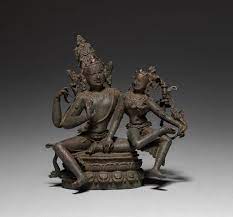Pala art flourished in the Indian subcontinent during the Pala Empire’s reign, from the 8th to the 12th century. Situated primarily in the eastern regions of present-day India and Bangladesh, the Pala dynasty produced exceptional art forms, reflecting the fusion of Indian, Tibetan, and Southeast Asian influences.

Table of Contents
Distinctive Features of Pala Art
Pala art, characterized by its exquisite craftsmanship and refined aesthetics, encompasses a wide range of artistic expressions. Key features include:
a. Sculpture: Pala sculpture exhibits a harmonious blend of Indian and Tibetan styles. Buddha and Bodhisattva figures, with serene expressions and elegant postures, dominate the sculptural repertoire. Notable are the richly ornamented bronze statues of Buddha and Tara, reflecting the spiritual depth and artistic finesse of the Pala artisans.
b. Manuscript Illuminations: Pala artists were masters of manuscript illuminations, creating intricately detailed and vibrant illustrations in Buddhist texts. The use of vegetable-based pigments and gold embellishments gave the manuscripts a luminous quality, making them visually captivating.
c. Stucco Art: Pala artists excelled in stucco art, crafting delicate and elaborate relief sculptures adorning temple walls and facades. The stucco works often depicted episodes from Buddha’s life and Jataka tales, illustrating moral and spiritual lessons.
Spiritual Significance of Pala Art
Buddhism played a pivotal role in shaping Pala art, and the artistic expressions were deeply imbued with spiritual significance. The art served as a means of propagating Buddhist teachings and fostering a sense of devotion among the people. Monasteries and temples were adorned with exquisite sculptures and paintings, creating sacred spaces for contemplation and worship.
Influence and Spread
Pala art’s impact extended far beyond the borders of the empire, influencing the art and architecture of neighboring regions, such as Nepal, Tibet, and Southeast Asia. The refinement and grace of Pala art inspired subsequent artistic traditions, leaving a lasting impression on the cultural heritage of these regions.
Legacy and Preservation
Despite the passage of centuries, Pala art remains a testament to the artistic brilliance of the Pala dynasty. Numerous artifacts and sculptures have been excavated from archaeological sites, providing valuable insights into the art and culture of the time. Museums and galleries worldwide house Pala art masterpieces, allowing enthusiasts to appreciate the legacy of this unique artistic tradition.
Pala art stands as a beacon of artistic excellence, spirituality, and cultural heritage of the Indian subcontinent. The graceful sculptures, vibrant manuscripts, and intricate stucco works created by Pala artisans continue to enchant art enthusiasts and scholars, underscoring the enduring allure of this remarkable artistic tradition. As we continue to celebrate and preserve the legacy of Pala art, we pay homage to the artistic brilliance and spiritual devotion of the Pala dynasty, leaving an indelible mark on the canvas of human civilization.
Important Links